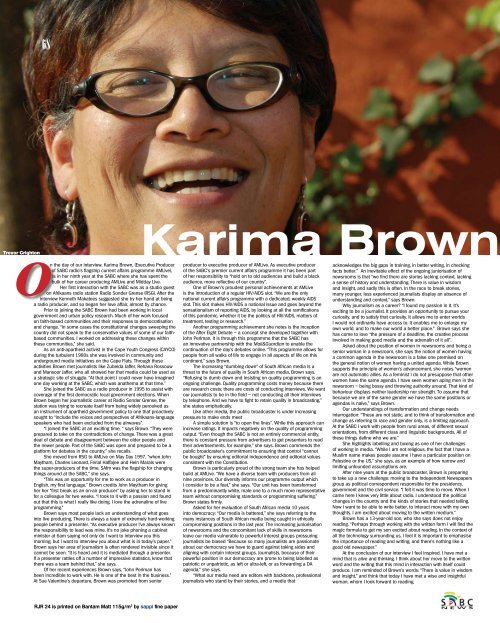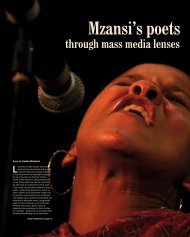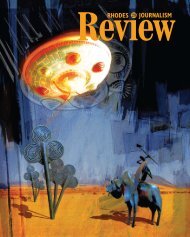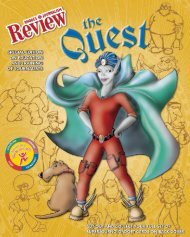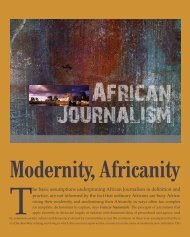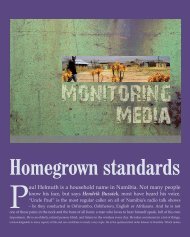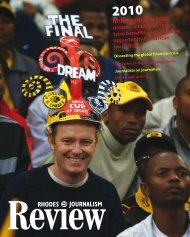FULL PDF - Rhodes Journalism Review - Rhodes University
FULL PDF - Rhodes Journalism Review - Rhodes University
FULL PDF - Rhodes Journalism Review - Rhodes University
You also want an ePaper? Increase the reach of your titles
YUMPU automatically turns print PDFs into web optimized ePapers that Google loves.
Trevor Crighton<br />
n the day of our interview, Karima Brown, (Executive Producer<br />
of SABC radio’s flagship current affairs programme AMLive),<br />
is in her ninth year at the SABC where she has spent the<br />
bulk of her career producing AMLive and Midday Live.<br />
Her first interaction with the SABC was as a studio guest<br />
on Afrikaans radio station Radio Sonder Grense (RSG). After the<br />
interview Kenneth Makatees suggested she try her hand at being<br />
a radio producer, and so began her love affair, almost by chance.<br />
Prior to joining the SABC Brown had been working in local<br />
government and urban policy research. Much of her work focused<br />
on faith-based communities and their responses to democratisation<br />
and change. “In some cases the constitutional changes sweeping the<br />
country did not speak to the conservative values of some of our faithbased<br />
communities. I worked on addressing these changes within<br />
these communities,” she said.<br />
As an anti-apartheid activist in the Cape Youth Congress (CAYCO)<br />
during the turbulent 1980s she was involved in community and<br />
underground media initiatives on the Cape Flats. Through these<br />
activities Brown met journalists like Zubeida Jaffer, Rehana Rossouw<br />
and Mansoor Jaffer, who all showed her that media could be used as<br />
a strategic site of struggle. “At that point I could never have imagined<br />
one day working at the SABC, which was anathema at that time.”<br />
She joined the SABC as a radio producer in 1995 to assist with<br />
coverage of the first democratic local government elections. When<br />
Brown began her journalistic career at Radio Sonder Grense, the<br />
station was trying to recreate itself from being widely perceived as<br />
an instrument of apartheid government policy to one that proactively<br />
sought to “include the voices and perspectives of Afrikaans-language<br />
speakers who had been excluded from the airwaves”.<br />
“I joined the SABC at an exciting time, “ says Brown. “They were<br />
prepared to take on the contradictions of change. There was a great<br />
deal of debate and disagreement between the older people and<br />
the newer people. Part of the SABC was open and prepared to be a<br />
platform for debates in the country,” she recalls.<br />
She moved from RSG to AMLive on May Day 1997, “when John<br />
Maytham, Charles Leonard, Ferial Haffajee and Hein Marais were<br />
the super-producers of the time. SAfm was the flagship for changing<br />
things around at the SABC,” she says.<br />
“This was an opportunity for me to work as a producer in<br />
English, my first language.” Brown credits John Maytham for giving<br />
her her “first break as an on-air producer” by asking her to stand in<br />
for a colleague for two weeks. “I took to it with a passion and found<br />
out that this is what I really like doing. I love the adrenaline of live<br />
programming.”<br />
Brown says most people lack an understanding of what goes<br />
into live producing. There is always a team of extremely hard-working<br />
people behind a presenter. “As executive producer I’ve always known<br />
the responsibility to lead was mine. It’s no joke phoning a cabinet<br />
minister at 6am saying not only do I want to interview you this<br />
morning, but I want to interview you about what is in today’s paper.”<br />
Brown says her area of journalism is often rendered invisible since it<br />
cannot be seen. “It is heard and it is mediated through a presenter.<br />
If a presenter rattles off a number of impressive statistics, know that<br />
there was a team behind that,” she says.<br />
Of her recent experiences Brown says, “John Perlman has<br />
been incredible to work with. He is one of the best in the business.”<br />
At Sue Valentine’s departure, Brown was promoted from senior<br />
RJR 24 is printed on Bantam Matt 115g/m 2 by sappi fine paper<br />
Karima Brown<br />
producer to executive producer of AMLive. As executive producer<br />
of the SABC’s premier current affairs programme it has been part<br />
of her responsibility to “hold on to old audiences and build a black<br />
audience, more reflective of our country”.<br />
One of Brown’s proudest personal achievements at AMLive<br />
is the introduction of a regular HIV/AIDS slot. “We are the only<br />
national current affairs programme with a dedicated, weekly AIDS<br />
slot. This slot makes HIV/AIDS a national issue and goes beyond the<br />
sensationalism of reporting AIDS, by looking at all the ramifications<br />
of this pandemic, whether it be the politics of HIV/AIDS, matters of<br />
treatment, testing or research.”<br />
Another programming achievement she notes is the inception<br />
of the After Eight Debate – a concept she developed together with<br />
John Perlman. It is through this programme that the SABC has<br />
an innovative partnership with the Mail&Guardian to enable the<br />
continuation of the day’s debates online. “This programme allows for<br />
people from all walks of life to engage in all aspects of life on this<br />
continent,” says Brown.<br />
The increasing “dumbing down” of South African media is a<br />
threat to the future of quality in South African media, Brown says.<br />
“Refusing to dumb down and insisting on quality programming is an<br />
ongoing challenge. Quality programming costs money because there<br />
are research costs; there are costs of conducting interviews. We want<br />
our journalists to be in the field – not conducting all their interviews<br />
by telephone. And we have to fight to retain quality in broadcasting,”<br />
she states emphatically.<br />
Like other media, the public broadcaster is under increasing<br />
pressure to make ends meet<br />
A simple solution is “to open the lines”. While this approach can<br />
increase ratings, it impacts negatively on the quality of programming<br />
output. “Even though the SABC is not an entirely commercial entity,<br />
there is constant pressure from advertisers to get presenters to read<br />
their advertisements, for example,” she says. Brown commends the<br />
public broadcaster’s commitment to ensuring that control “cannot<br />
be bought” by ensuring editorial independence and editorial values<br />
consistent with the Constitution.<br />
Brown is particularly proud of the strong team she has helped<br />
build at AMLive. “We have a diverse team with producers from all<br />
nine provinces. Our diversity informs our programme output which<br />
I consider to be a feat,” she says. “Our unit has been transformed<br />
from a predominantly white, male one to a much more representative<br />
team without compromising standards or programming suffering,”<br />
Brown states firmly.<br />
Asked for her evaluation of South African media 10 years<br />
into democracy: “Our media is battered,” she says referring to the<br />
many instances of South African media being caught in ethically<br />
compromising positions in the last year. The increasing juniorisation<br />
of newsrooms and the concomitant lack of skills in newsrooms<br />
leave our media vulnerable to powerful interest groups pressuring<br />
journalists be biased “Because so many journalists are passionate<br />
about our democracy we have to guard against taking sides and<br />
aligning with certain interest groups. Journalists, because of their<br />
powerful position in our democracy are prone to being labelled as<br />
patriotic or unpatriotic, as left or ultra-left, or as forwarding a DA<br />
agenda,” she says.<br />
“What our media need are editors with backbone, professional<br />
journalists who stand by their stories, and a media that<br />
acknowledges the big gaps in training, in better writing, in checking<br />
facts better.” An inevitable effect of the ongoing juniorisation of<br />
newsrooms is that “we find there are stories lacking context, lacking<br />
a sense of history and understanding. There is value in wisdom<br />
and insight, and sadly this is often. In the race to break stories,<br />
many younger, less experienced journalists display an absence of<br />
understanding and context,” says Brown.<br />
Why journalism as a career? “I found my passion in it. It’s<br />
exciting to be a journalist. It provides an opportunity to pursue your<br />
curiosity, and to satisfy that curiosity. It allows me to enter worlds<br />
I would not ordinarily have access to. It enables me to enlarge my<br />
own world, and to make our world a better place.” Brown says she<br />
has come to love “the pressure of a deadline, the creative process<br />
involved in making good media and the adrenalin of it all”.<br />
Asked about the position of women in newsrooms and being a<br />
senior woman in a newsroom, she says the notion of women having<br />
a common agenda in the newsroom is a false one premised on<br />
the general notion of women having a united agenda. While Brown<br />
supports the principle of women’s advancement, she notes “women<br />
are not automatic allies. As a feminist I do not presuppose that other<br />
women have the same agenda. I have seen women aping men in the<br />
newsroom – being bossy and throwing authority around. That kind of<br />
behaviour displays neither leadership nor strength. To assume that<br />
because we are of the same gender we have the same positions or<br />
agendas is naïve,” says Brown.<br />
Our understandings of transformation and change needs<br />
interrogation: “These are not static, and to think of transformation and<br />
change as referring to race and gender only, is a limiting approach.<br />
At the SABC I work with people from rural areas, of different sexual<br />
orientations, from different class and linguistic backgrounds. All of<br />
these things define who we are.”<br />
She highlights labelling and boxing as one of her challenges<br />
of working in media. “While I am not religious, the fact that I have a<br />
Muslim name makes people assume I have a particular position on<br />
Palestine or the US,” she says, as an example of how narrow and<br />
limiting unfounded assumptions are.<br />
After nine years at the public broadcaster, Brown is preparing<br />
to take up a new challenge: moving to the Independent Newspapers<br />
group as political correspondent responsible for the presidency,<br />
government and the civil service. “I felt it was time to move. When I<br />
came here I knew very little about radio. I understood the political<br />
changes in the country and the kinds of stories that needed telling.<br />
Now I want to be able to write better, to interact more with my own<br />
thoughts. I am excited about moving to the written medium.”<br />
Brown has a 13-year-old son, who she says does not enjoy<br />
reading. “Perhaps through working with the written form I will find the<br />
magic formula to get my son excited about reading. In the context of<br />
all the technology surrounding us, I feel it is important to emphasise<br />
the importance of reading and writing, and there’s nothing like a<br />
good old newspaper.”<br />
At the conclusion of our interview I feel inspired. I have met a<br />
mind that is alive and thinking. I think about her move to the written<br />
word and the writing that this mind in interaction with itself could<br />
produce. I am reminded of Brown’s words: “There is value in wisdom<br />
and insight,” and think that today I have met a wise and insightful<br />
woman, whom I look forward to reading.


